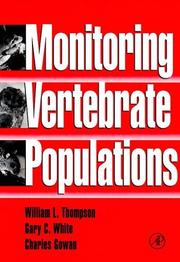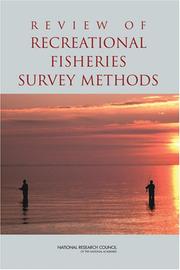| Listing 1 - 7 of 7 |
Sort by
|
Book
Year: 2010 Publisher: Fort Collins, Colorado : U.S. Department of the Interior, National Park Service, Natural Resource Program Center,
Abstract | Keywords | Export | Availability | Bookmark
 Loading...
Loading...Choose an application
- Reference Manager
- EndNote
- RefWorks (Direct export to RefWorks)
Biodiversity conservation --- Vertebrate surveys --- Plants --- Cumberland Gap National Historical Park --- Environmental conditions.
Book
Year: 2010 Publisher: Fort Collins, Colorado : U.S. Department of the Interior, National Park Service, Natural Resource Program Center,
Abstract | Keywords | Export | Availability | Bookmark
 Loading...
Loading...Choose an application
- Reference Manager
- EndNote
- RefWorks (Direct export to RefWorks)
Biodiversity conservation --- Vertebrate surveys --- Plants --- Cumberland Gap National Historical Park --- Environmental conditions.

ISBN: 0126889600 9780126889604 9780080536941 0080536948 1281029459 9781281029454 9786611029456 Year: 1998 Publisher: San Diego : Academic Press,
Abstract | Keywords | Export | Availability | Bookmark
 Loading...
Loading...Choose an application
- Reference Manager
- EndNote
- RefWorks (Direct export to RefWorks)
This book is written to serve as a general reference for biologists and resource managers with relatively little statistical training. It focuses on both basic concepts and practical applications to provide professionals with the tools needed to assess monitoring methods that can detect trends in populations. It combines classical finite population sampling designs with population enumeration procedures in a unified approach for obtaining abundance estimates for species of interest. The statistical information is presented in practical, easy-to-understand terminology.Key Features*
General ecology and biosociology --- Vertebrates --- Vertebrate populations - Measurement --- Vertebrates - Monitoring --- Vertebrate surveys --- Vertebrate populations --- Vertebrate surveys. --- Vertebrate inventories --- Vertebrate zoological surveys --- Zoological surveys --- Vertebrata --- Chordata --- Animal populations --- Measurement. --- Monitoring.
Book
ISBN: 0140470875 9780140470871 Year: 1976 Publisher: Harmondsworth Penguin books
Abstract | Keywords | Export | Availability | Bookmark
 Loading...
Loading...Choose an application
- Reference Manager
- EndNote
- RefWorks (Direct export to RefWorks)
Bird surveys --- Birds --- Bird populations --- Counting --- #WDIR:wbse --- Bird populations. --- Bird surveys. --- Counting. --- Avifaunal surveys --- Bird inventories --- Ornithological inventories --- Ornithological surveys --- Ornithology --- Vertebrate surveys --- Vertebrate populations --- Methodology --- Estimates --- Birds - Counting

ISBN: 1280542527 9786610542529 0309660750 9780309660754 030910193X 9780309101936 030910193X 9780309101936 0309180252 9781280542527 661054252X Year: 2006 Publisher: Washington, DC : ©2006 National Academies Press,
Abstract | Keywords | Export | Availability | Bookmark
 Loading...
Loading...Choose an application
- Reference Manager
- EndNote
- RefWorks (Direct export to RefWorks)
Recreational fishing in the United States is an important social and economic component of many marine fisheries, with an estimated 14 million anglers making almost 82 million fishing trips in 2004. Although each individual angler typically harvests a small number of fish, collectively these sport fisheries can take a significant fraction of the yearly catch -- in some cases more than commercial fisheries. For example, in 1999, recreational fishing accounted for 94% of the total catch of spotted sea trout, 76% of striped bass and sheephead, and 60% of king mackerel. It is important that systems used to monitor fishing catch are adequate for timely management of recreational fisheries. However, the large number of anglers and access points makes monitoring recreational fishing much more difficult than monitoring commercial fishing. This report reviews the types of survey methods used to estimate catch in recreational fisheries, including state/federal cooperative programs. The report finds that both telephone survey and onsite access components of the current monitoring systems have serious flaws in design or implementation. There are also several areas of miscommunication and mismatched criteria among designers of surveys, data collectors, and recreational fisheries. The report recommends that a comprehensive, universal sampling frame with national coverage should be established, and that improvements should be made in statistical analysis of the data collected and in the ways the data are communicated. A permanent and independent research group should be established and funded to evaluate the statistical design and adequacy of recreational fishery surveys and to guide necessary modifications or new initiatives.
Fish surveys --- Fishery management. --- Fish management --- Fisheries --- Fisheries management --- Fishery resources --- Aquatic resources --- Wildlife management --- Fish counting towers --- Overfishing --- Fish inventories --- Ichthyological inventories --- Ichthyological surveys --- Ichthyology --- Vertebrate surveys --- Management --- Methodology
Book
ISBN: 9789086862665 9789050115377 9050115373 9086862667 9086868789 Year: 2015 Publisher: Leiden ; Boston : Brill | Wageningen Academic,
Abstract | Keywords | Export | Availability | Bookmark
 Loading...
Loading...Choose an application
- Reference Manager
- EndNote
- RefWorks (Direct export to RefWorks)
The atlas presents a unique set of abundance data to describe the spatial, depth, size, and temporal distribution of demersal and pelagic fish species over an extensive marine area, together with accounts of their biology. A large number of pictures, graphs and distribution maps illustrate the text. By largely avoiding - or at least explaining - scientific terms and providing extensive references, the book should be useful for both laymen and scientists. The quantitative information on some 200 fish taxa is derived from 72,000 stations fished by research vessels during the period 1977-2013. The area covers the northwest European shelf from west of Ireland to the central Baltic Sea and from Brittany to the Shetlands. Although the surveys extend beyond the shelf edge, only taxa reported at least once in waters less than 200 m are included. Typical deep-water species and typical fresh-water species are excluded. We hope this publication will contribute to gaining a better understanding of the ocean ecosystems.
Fishes --- Poissons --- Marine fishes --- Fish surveys --- Fish populations --- Saltwater fishes --- Sea fishes --- Marine animals --- Fish inventories --- Ichthyological inventories --- Ichthyological surveys --- Ichthyology --- Vertebrate surveys --- Fish stocks --- Population dynamics of fishes --- Populations, Fish --- Stocks, Fish --- Vertebrate populations --- Geographical distribution. --- Methodology --- Population dynamics --- Stocks --- Geographical distribution --- Atlantic Ocean --- North Atlantic Ocean. --- Baltiĭskoe more --- Baltiskoye more --- Baltiyskoye more --- Europe --- Mare Suevicum --- Marine fishes - Celtic Sea --- Marine fishes - North Sea --- Marine fishes - Baltic Sea --- Marine fishes - Celtic Sea - Geographical distribution --- Marine fishes - North Sea - Geographical distribution --- Marine fishes - Baltic Sea - Geographical distribution --- Fish surveys - Celtic Sea --- Fish surveys - North Sea --- Fish surveys - Baltic Sea --- Fish populations - North Atlantic Ocean
Book
ISBN: 1282134183 9786613806765 0520953495 9780520953499 9780520273108 0520273109 9781282134188 6613806765 Year: 2012 Publisher: Berkeley : University of California Press,
Abstract | Keywords | Export | Availability | Bookmark
 Loading...
Loading...Choose an application
- Reference Manager
- EndNote
- RefWorks (Direct export to RefWorks)
Each year shorebirds from North and South America migrate thousands of miles to spend the summer in the Arctic. There they feed in shoreline marshes and estuaries along some of the most productive and pristine coasts anywhere. With so much available food they are able to reproduce almost explosively; and as winter approaches, they retreat south along with their offspring, to return to the Arctic the following spring. This remarkable pattern of movement and activity has been the object of intensive study by an international team of ornithologists who have spent a decade counting, surveying, and observing these shorebirds. In this important synthetic work, they address multiple questions about these migratory bird populations. How many birds occupy Arctic ecosystems each summer? How long do visiting shorebirds linger before heading south? How fecund are these birds? Where exactly do they migrate and where exactly do they return? Are their populations growing or shrinking? The results of this study are crucial for better understanding how environmental policies will influence Arctic habitats as well as the far-ranging winter habitats used by migratory shorebirds.
Bird surveys --- Shore birds --- Avifaunal surveys --- Bird inventories --- Ornithological inventories --- Ornithological surveys --- Ornithology --- Vertebrate surveys --- Beach birds --- Shorebirds --- Seashore animals --- Water birds --- Methodology --- arctic ecosystems. --- arctic habitats. --- bird population. --- bird science. --- bird watchers. --- birds in the cold. --- birds in the winter. --- books about birds. --- books for animal lovers. --- conservation of birds. --- distractions for kids. --- educational books. --- environment books. --- environmental ecosystem. --- head south for the winter. --- home school science books. --- interesting books. --- leisure reads. --- life sciences. --- nature lovers. --- ornithology. --- passion books. --- planet earth lovers. --- shorebirds. --- vacation books. --- wildlife. --- winter habitats. --- zoology.
| Listing 1 - 7 of 7 |
Sort by
|

 Search
Search Feedback
Feedback About
About Help
Help News
News